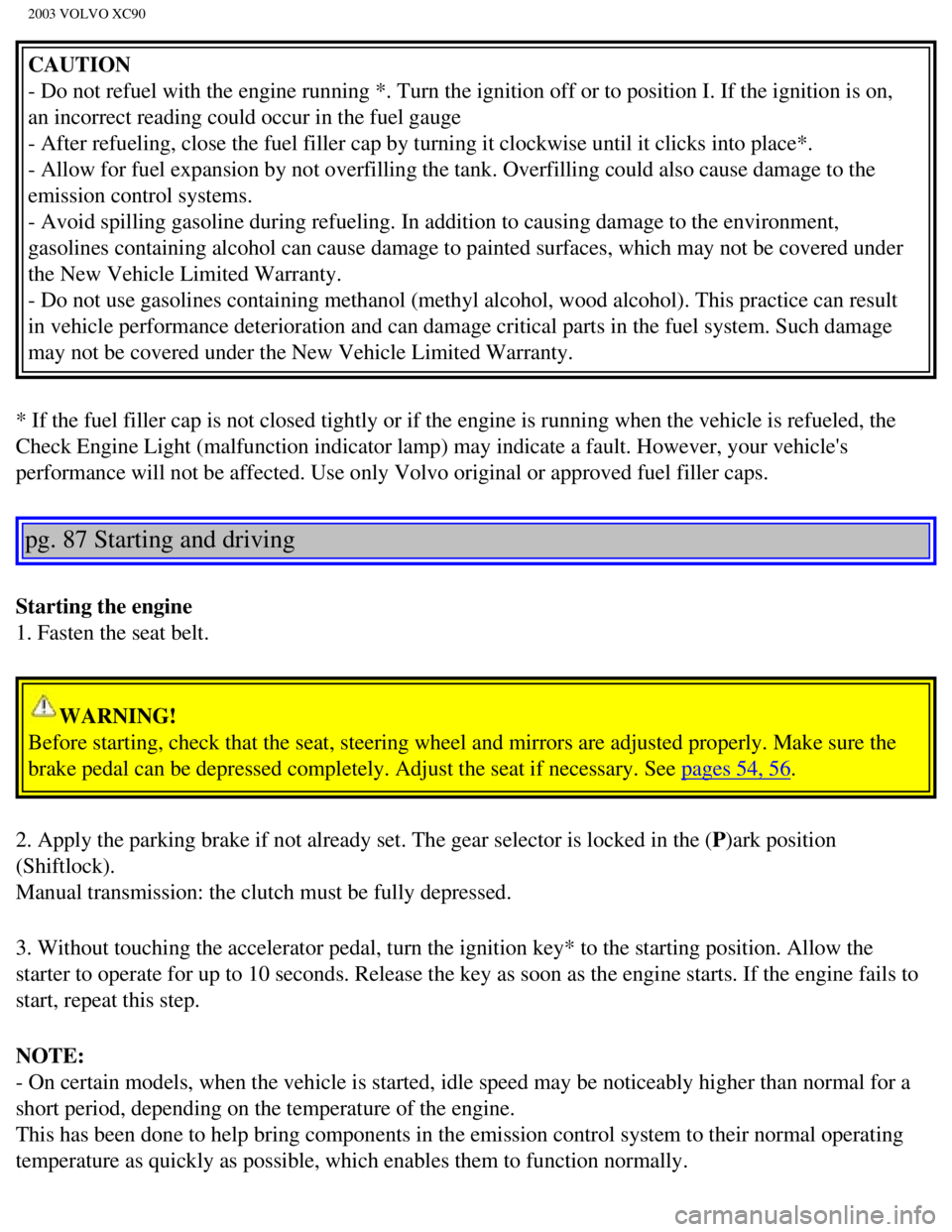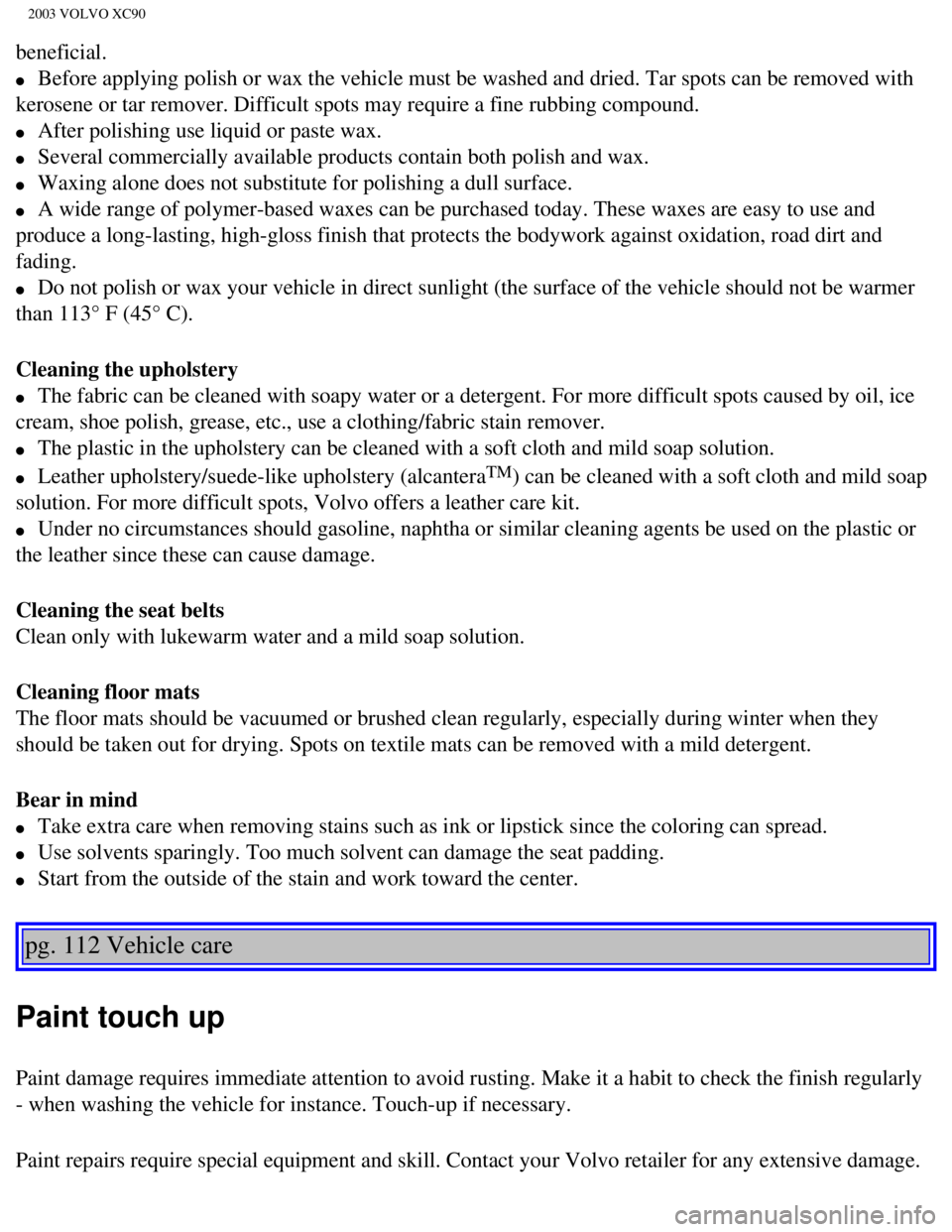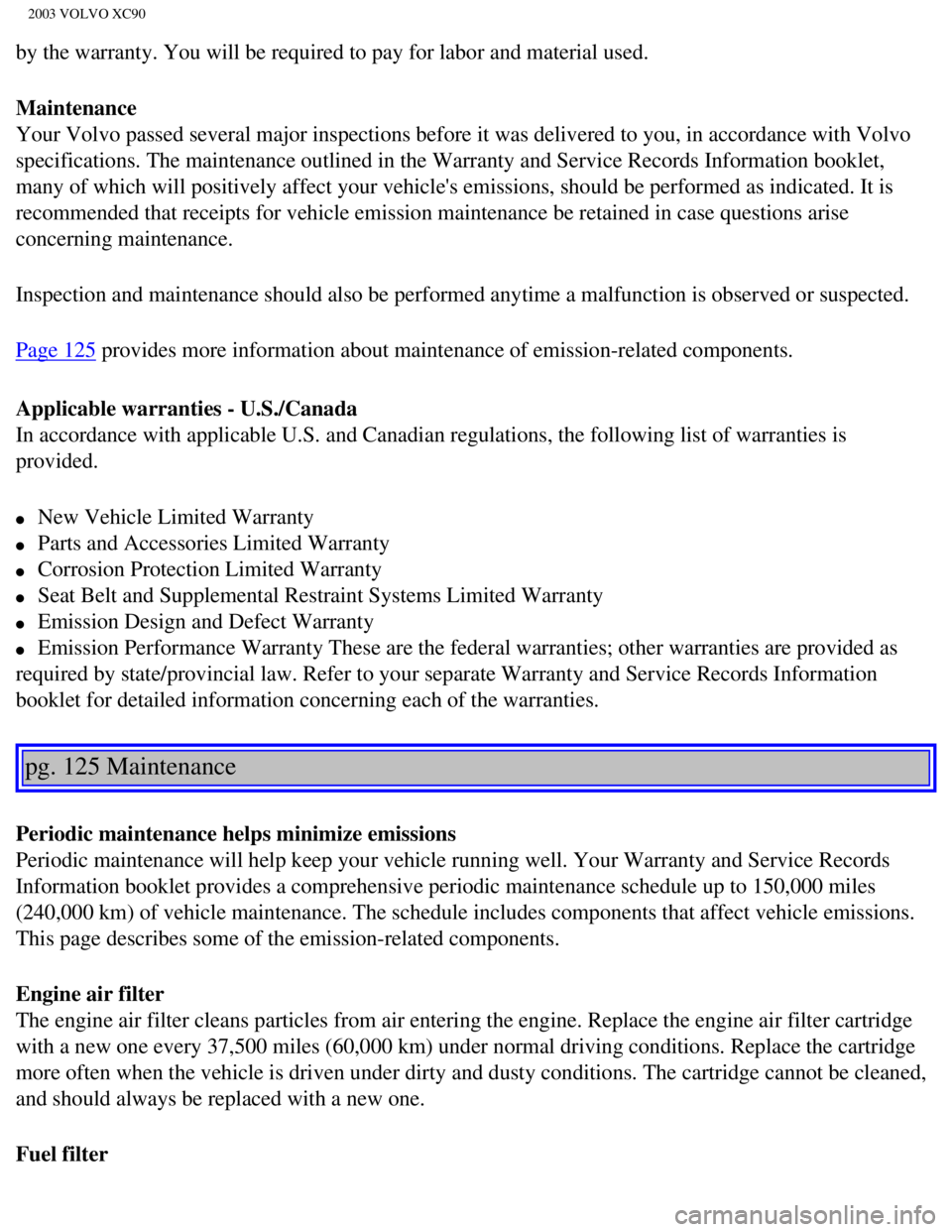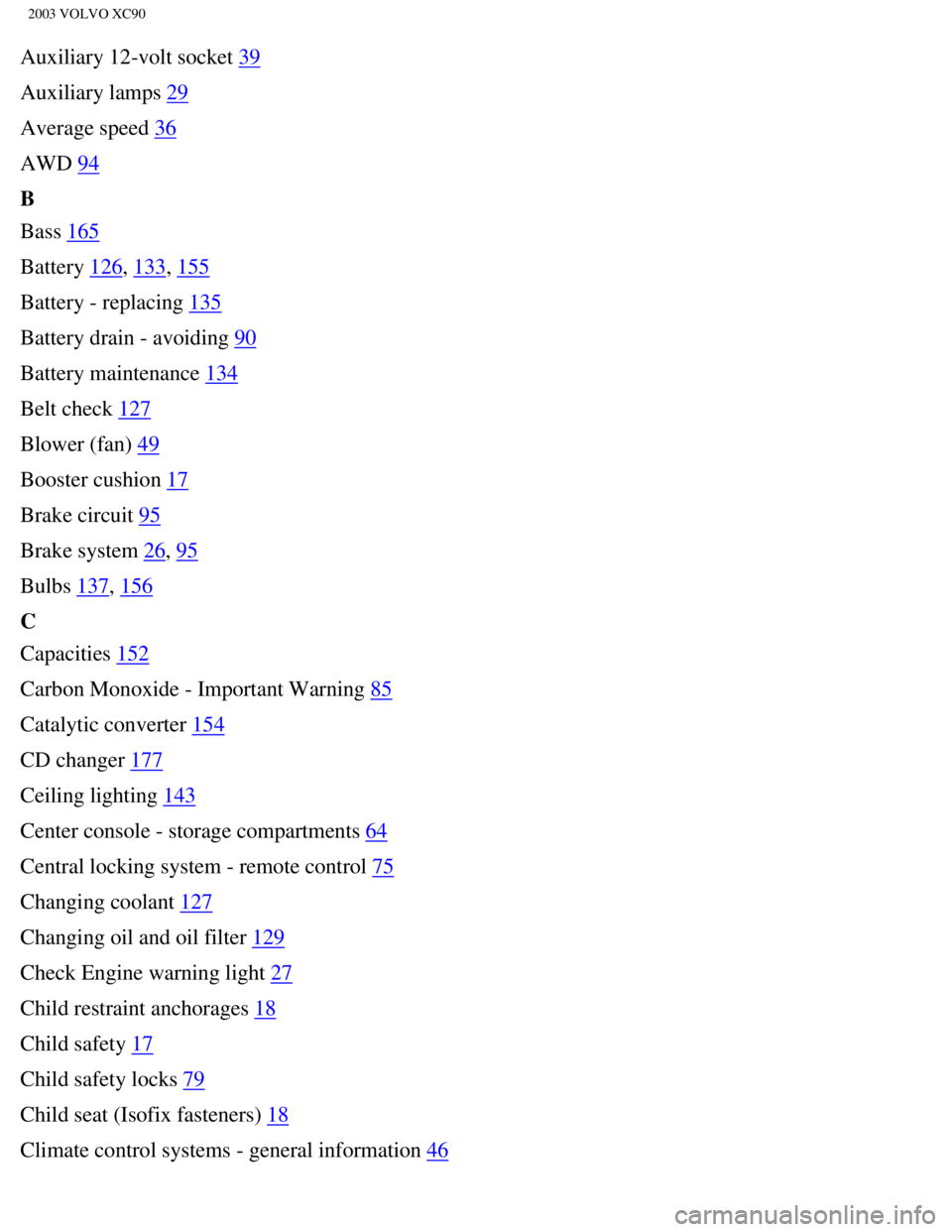2003 VOLVO XC90 belt
[x] Cancel search: beltPage 108 of 242

2003 VOLVO XC90
CAUTION
- Do not refuel with the engine running *. Turn the ignition off or to p\
osition I. If the ignition is on,
an incorrect reading could occur in the fuel gauge
- After refueling, close the fuel filler cap by turning it clockwise unt\
il it clicks into place*.
- Allow for fuel expansion by not overfilling the tank. Overfilling coul\
d also cause damage to the
emission control systems.
- Avoid spilling gasoline during refueling. In addition to causing damag\
e to the environment,
gasolines containing alcohol can cause damage to painted surfaces, which\
may not be covered under
the New Vehicle Limited Warranty.
- Do not use gasolines containing methanol (methyl alcohol, wood alcoho\
l). This practice can result
in vehicle performance deterioration and can damage critical parts in th\
e fuel system. Such damage
may not be covered under the New Vehicle Limited Warranty.
* If the fuel filler cap is not closed tightly or if the engine is runni\
ng when the vehicle is refueled, the
Check Engine Light (malfunction indicator lamp) may indicate a fault. \
However, your vehicle's
performance will not be affected. Use only Volvo original or approved fu\
el filler caps.
pg. 87 Starting and driving
Starting the engine
1. Fasten the seat belt.
WARNING!
Before starting, check that the seat, steering wheel and mirrors are adj\
usted properly. Make sure the
brake pedal can be depressed completely. Adjust the seat if necessary. S\
ee
pages 54, 56.
2. Apply the parking brake if not already set. The gear selector is lock\
ed in the (P)ark position
(Shiftlock).
Manual transmission: the clutch must be fully depressed.
3. Without touching the accelerator pedal, turn the ignition key* to the\
starting position. Allow the
starter to operate for up to 10 seconds. Release the key as soon as the \
engine starts. If the engine fails to
start, repeat this step.
NOTE:
- On certain models, when the vehicle is started, idle speed may be noti\
ceably higher than normal for a
short period, depending on the temperature of the engine.
This has been done to help bring components in the emission control syst\
em to their normal operating
temperature as quickly as possible, which enables them to function norma\
lly.
file:///K|/ownersdocs/2003/2003_XC90/03xc90_06a.htm (5 of 15)12/30/200\
6 4:18:58 PM
Page 134 of 242

2003 VOLVO XC90
page 128 for the location of the washer fluid reservoir).
This is important since dirt is often splashed on the windshield during \
winter driving, requiring the
frequent use of the washers and wipers. Volvo Washer Solvent should be d\
iluted as follows:
Down to 14° F (-10° C): 1 part washer solvent and 4 parts water \
Down to 5° F (-15° C): 1 part washer solvent and 3 parts water
Down to 0° F (-18° C): 1 part washer solvent and 2 parts water
Down to -18° F (-28° C): 1 part washer solvent and 1 part water \
l Use Volvo Teflon Lock Spray in the locks.
NOTE: Avoid the use of de-icing sprays as they can cause damage to the locks.
W Winter/Wet driving modeÐenhanced vehicle traction
l Mode W will only function if the gear selector is in the (D)rive position.
l Press the button at the base of the gear selector to engage/disengage th\
is driving mode.
l An LED in the button will light up to indicate that W is engaged and thi\
s will also be displayed in the
instrument panel (see
page 24).
l This mode may be selected for starting/moving off on slippery roads.
* Synthetic oil is not used when the oil is changed at the normal mainte\
nance intervals except at owner
request and at additional charge. Please consult your Volvo retailer.
pg. 108 Starting and driving
Before a long distance trip
It is always worthwhile to have your vehicle checked at a Volvo retailer\
before driving long distances.
Your retailer will also be able to supply you with bulbs, fuses, spark p\
lugs and wiper blades for your use
in the event that problems occur.
As a minimum, the following items should be checked before any long trip\
:
l Check that engine runs smoothly and that fuel consumption is normal.
l Check for fuel, oil, and fluid leakage
l Check transmission oil level*.
l Check condition of drive belts.
l Check state of the battery's charge.
l Examine tires carefully (the spare tire as well), and replace those th\
at are worn. Check tire pressures.
l The brakes, front wheel alignment, and steering gear should be checked b\
y your Volvo retailer only.
l Check all lights, including high beams.
l Reflective warning triangles are legally required in some states/provinc\
es.
l Have a word with your Volvo retailer if you intend to drive in countries\
where it may be difficult to
obtain the correct fuel.
file:///K|/ownersdocs/2003/2003_XC90/03xc90_06b.htm (16 of 17)12/30/20\
06 4:18:59 PM
Page 138 of 242

2003 VOLVO XC90
beneficial.
l Before applying polish or wax the vehicle must be washed and dried. Tar \
spots can be removed with
kerosene or tar remover. Difficult spots may require a fine rubbing comp\
ound.
l After polishing use liquid or paste wax.
l Several commercially available products contain both polish and wax.
l Waxing alone does not substitute for polishing a dull surface.
l A wide range of polymer-based waxes can be purchased today. These waxes \
are easy to use and
produce a long-lasting, high-gloss finish that protects the bodywork aga\
inst oxidation, road dirt and
fading.
l Do not polish or wax your vehicle in direct sunlight (the surface of th\
e vehicle should not be warmer
than 113° F (45° C).
Cleaning the upholstery
l The fabric can be cleaned with soapy water or a detergent. For more diff\
icult spots caused by oil, ice
cream, shoe polish, grease, etc., use a clothing/fabric stain remover.
l The plastic in the upholstery can be cleaned with a soft cloth and mild \
soap solution.
l Leather upholstery/suede-like upholstery (alcanteraTM) can be cleaned with a soft cloth and mild soap
solution. For more difficult spots, Volvo offers a leather care kit.
l Under no circumstances should gasoline, naphtha or similar cleaning agen\
ts be used on the plastic or
the leather since these can cause damage.
Cleaning the seat belts
Clean only with lukewarm water and a mild soap solution.
Cleaning floor mats
The floor mats should be vacuumed or brushed clean regularly, especially\
during winter when they
should be taken out for drying. Spots on textile mats can be removed wit\
h a mild detergent.
Bear in mind
l Take extra care when removing stains such as ink or lipstick since the c\
oloring can spread.
l Use solvents sparingly. Too much solvent can damage the seat padding.
l Start from the outside of the stain and work toward the center.
pg. 112 Vehicle care
Paint touch up
Paint damage requires immediate attention to avoid rusting. Make it a ha\
bit to check the finish regularly
- when washing the vehicle for instance. Touch-up if necessary.
Paint repairs require special equipment and skill. Contact your Volvo re\
tailer for any extensive damage.
file:///K|/ownersdocs/2003/2003_XC90/03xc90_07.htm (3 of 5)12/30/2006 \
4:19:00 PM
Page 154 of 242

2003 VOLVO XC90
by the warranty. You will be required to pay for labor and material used\
.
Maintenance
Your Volvo passed several major inspections before it was delivered to y\
ou, in accordance with Volvo
specifications. The maintenance outlined in the Warranty and Service Rec\
ords Information booklet,
many of which will positively affect your vehicle's emissions, should be\
performed as indicated. It is
recommended that receipts for vehicle emission maintenance be retained i\
n case questions arise
concerning maintenance.
Inspection and maintenance should also be performed anytime a malfunctio\
n is observed or suspected.
Page 125 provides more information about maintenance of emission-related compone\
nts.
Applicable warranties - U.S./Canada
In accordance with applicable U.S. and Canadian regulations, the followi\
ng list of warranties is
provided.
l New Vehicle Limited Warranty
l Parts and Accessories Limited Warranty
l Corrosion Protection Limited Warranty
l Seat Belt and Supplemental Restraint Systems Limited Warranty
l Emission Design and Defect Warranty
l Emission Performance Warranty These are the federal warranties; other wa\
rranties are provided as
required by state/provincial law. Refer to your separate Warranty and Se\
rvice Records Information
booklet for detailed information concerning each of the warranties.
pg. 125 Maintenance
Periodic maintenance helps minimize emissions
Periodic maintenance will help keep your vehicle running well. Your Warr\
anty and Service Records
Information booklet provides a comprehensive periodic maintenance schedu\
le up to 150,000 miles
(240,000 km) of vehicle maintenance. The schedule includes components \
that affect vehicle emissions.
This page describes some of the emission-related components.
Engine air filter
The engine air filter cleans particles from air entering the engine. Rep\
lace the engine air filter cartridge
with a new one every 37,500 miles (60,000 km) under normal driving con\
ditions. Replace the cartridge
more often when the vehicle is driven under dirty and dusty conditions. \
The cartridge cannot be cleaned,
and should always be replaced with a new one.
Fuel filter
file:///K|/ownersdocs/2003/2003_XC90/03xc90_09a.htm (2 of 15)12/30/200\
6 4:19:02 PM
Page 155 of 242

2003 VOLVO XC90
The fuel filter should be replaced at 120,000 miles (193,000 km). The \
filter is replaced as a complete
unit. Replace more frequently if contaminated fuel is introduced into th\
e tank, or if there is reason to
suspect that this has occurred.
Fuel system, including filler cap, tank, lines, and connections
The ability of the fuel system to contain hydrocarbons depends upon a le\
ak-free system. Inspect fuel
lines every 30,000 miles (48,000 km). Check for proper sealing of the \
fuel filler cap, which contains "O"
ring seals.
NOTE: If the fuel filler cap is not closed tightly or if the engine is running\
when the vehicle is refueled,
the Check Engine light (Malfunction Indicator) may indicate a fault. H\
owever, your vehicle's
performance will not be affected. Use only Volvo original or approved fu\
el filler caps.
Timing belt
For proper functioning of the engine and emission control systems, the t\
iming belt and belt pretensioner
must be replaced every 120,000 miles (193,000 km). Engine damage will \
occur if the belt fails.
PCV system
(on turbocharged models)
The nipple in the intake manifold and the filter at the end of the PCV h\
ose in the air cleaner should be
inspected and cleaned at 120,000 miles (193,000 km), and again at 150,\
000 miles (240,000 km).
Spark plugs
The spark plugs should be replaced every 60,000 miles (96,000 km) unde\
r normal driving conditions.
City driving or fast highway driving may necessitate replacement sooner.\
Under normal driving conditions, spark plugs require no maintenance betw\
een replacement intervals.
When installing new plugs, be sure to use the right type and to tighten \
them correctly. When changing
the plugs, clean the terminals and rubber seals. Also check that the sup\
pressor connectors are in good
condition. Cracked or damaged connectors should be replaced.
pg. 126 Maintenance
file:///K|/ownersdocs/2003/2003_XC90/03xc90_09a.htm (3 of 15)12/30/200\
6 4:19:02 PM
Page 157 of 242

2003 VOLVO XC90
WARNING!
The ignition system has very high voltage! The voltage in the ignition s\
ystem is dangerous!
Do not touch spark plugs, ignition cables or the ignition coil when the \
engine is running or the
ignition is switched on!
The ignition should be switched off when:
- Conducting engine tests.
- Replacing parts in the ignition system, such as spark plugs, ignition \
coil, distributor, ignition cables,
etc.
- Never try to repair any part of the SRS/ SIPS/WHIPS/IC systems yoursel\
f. Any interference in the
system could cause malfunction and serious injury. Any work should only \
be performed by an
authorized Volvo workshop.
pg. 127 Maintenance
Belt check
Check the belt regularly to make sure it is in good condition and is cle\
an. A worn or dirty belt can cause
poor cooling and low alternator output as well as impair the operation o\
f the power steering and the air
conditioning unit.
NOTE: The drive belt is equipped with a self-tensioning mechanism and requires\
no adjustment
between changes.
WARNING!
The engine must not be running when this check is
performed.
Check coolant level
The cooling system must be filled with coolant and not leak to operate a\
t maximum efficiency. Check
the coolant level regularly. The level should be between the "MAX" and "\
MIN" marks on the expansion
tank. The check should be made with particular thoroughness when the eng\
ine is new or when the
cooling system has been drained.
Do not remove the filler cap other than for topping up with coolant. Fre\
quent removal may prevent
coolant circulation between the engine and the expansion tank during eng\
ine warm up and cooling.
Changing coolant
file:///K|/ownersdocs/2003/2003_XC90/03xc90_09a.htm (5 of 15)12/30/200\
6 4:19:02 PM
Page 230 of 242

2003 VOLVO XC90
Auxiliary 12-volt socket 39
Auxiliary lamps
29
Average speed
36
AWD
94
B
Bass
165
Battery
126, 133, 155
Battery - replacing
135
Battery drain - avoiding
90
Battery maintenance
134
Belt check
127
Blower (fan)
49
Booster cushion
17
Brake circuit
95
Brake system
26, 95
Bulbs
137, 156
C
Capacities
152
Carbon Monoxide - Important Warning
85
Catalytic converter
154
CD changer
177
Ceiling lighting
143
Center console - storage compartments
64
Central locking system - remote control
75
Changing coolant
127
Changing oil and oil filter
129
Check Engine warning light
27
Child restraint anchorages
18
Child safety
17
Child safety locks
79
Child seat (Isofix fasteners)
18
Climate control systems - general information
46
file:///K|/ownersdocs/2003/2003_XC90/03xc90_12.htm (2 of 14)12/30/2006\
4:19:09 PM
Page 235 of 242

2003 VOLVO XC90
Parking lights 31
Polishing
111
Power seat
56
Power steering fluid
132
Power moonroof
43
PROPOSITION 65 WARNING
102, 136
R
Radiator
128
Rain sensor - windshield wipers
34
Reading lights
61
Rear fog lights
31
Rear seat air condition
29
Rear suspension
153
Rear window defroster
35
Rearview mirror/door mirrors
42
Recirculation
50
REDUCE SPEED
28
Refrigerant (A/C system)
46
Refueling
84, 86
Remote control - central locking system
75
Reporting safety defects
21
Reverse warning system
29
Roadholding
90
Roll Stability Control (RSC)
97
S
Safety
1
Safety defects - reporting
21
Seat belt
2
Seat belt maintenance
21
Seat belt reminder
42
Seat belts (keeping child seats in place)
20
SEL button
162
file:///K|/ownersdocs/2003/2003_XC90/03xc90_12.htm (7 of 14)12/30/2006\
4:19:09 PM